Blackfin Snapper
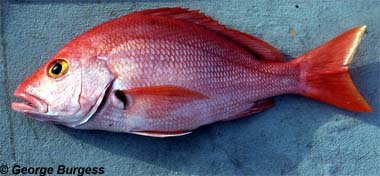
Lutjanus buccanella
This classic 12-inch snapper has the typical almond-shaped body, double dorsal fin, and short caudal (tail) fin. It is a rich red color that fades to a silvery underside, and there is a distinct black comma mark at the base of its pectoral fin that distinguishes it from similar looking snappers. They live in the Western Atlantic, preferring sandy or rocky offshore habitats where they can school in small groups.
Order – Perciformes
Family – Lutjanidae
Genus – Lutjanus
Species – bucanella
Common Names
English language common names include blackfin snapper, blackspot snapper, blackfin red snapper, gun-mouth backfin, gun-mouth snapper, redfish, and wrenchman. The common name “blackfin” refers to the dark spot located at the base of the pectoral fins.
Other common names include boucanella (French), cala di hundu (Papiamento), cala pretu (Papiamento), chillo oreja negra (Spanish), lucjan bukanela (Polish), oreille noire (French), pargo (Spanish), pargo sesi (Spanish), sesi (Spanish), sesi de lo alto (Spanish), vivaneau oreille noire (French), and zorèy nwè (Creole).
Importance to Humans
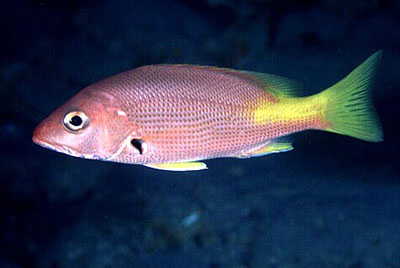
The blackfin snapper is a popular game and excellent food fish. It is sometimes marketed as red snapper. It is caught with handlines, rod and reel, traps, and gill nets, and is mainly a recreational sportfish rather than a commercial fish. There have been a few reports of ciguatera poisoning from human consumption of this snapper.
Conservation
The blackfin snapper is not listed as endangered or vulnerable with the World Conservation Union (IUCN). The IUCN is a global union of states, governmental agencies, and non-governmental organizations in a partnership that assesses the conservation status of species.
> Check the status of the blackfin snapper at the IUCN website.
Geographical Distribution
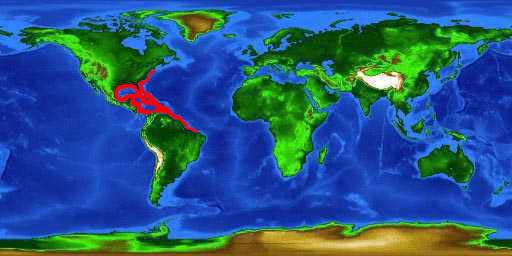
The blackfin snapper is found in the tropical West Atlantic Ocean, from Massachusetts to Brazil, although it is rare north of North Carolina. It is also found near shorelines in the Gulf of Mexico and common throughout the Caribbean.
Habitat
Living over sandy and rocky bottoms near ledges, the blackfin snapper occurs in waters 200-300 feet (60 to 90m) deep. The adults live offshore near the continental shelf. The young typically inhabit rocky outcroppings near reefs in shallow waters of 20-60 feet (6-18m). The blackfin snapper is often observed schooling in groups of 20-30 individuals.
Biology
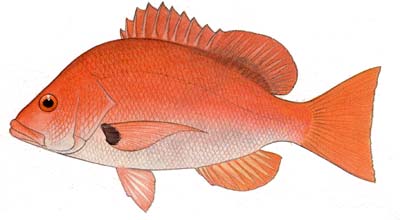
Distinctive Features
This snapper is similar to others in the Lutjanidae family because it has the same deep body and double dorsal fin. Its caudal fin is rather truncate-shaped and it has a long pectoral fin. The anal fin is rounded.
This snapper is often confused with the northern red snapper (Lutjanus campechanus) however the comma-shaped black mark at the base of the pectoral fins is a distinguishing characteristic of the blackfin snapper. Also, the blackfin snapper has a rounded anal fin in contrast to the pointed anal fin of the red snapper.
Coloration
The blackfin snapper is generally red in color, silvery-red below, with yellowish caudal, anal and pelvic fins. There is a distinct dark comma-shaped mark at the base of the pectoral fins, giving this fish its common name. Juveniles are similar in appearance to the adults, while having a broad bright yellow area on the upper part of the caudal penduncle.
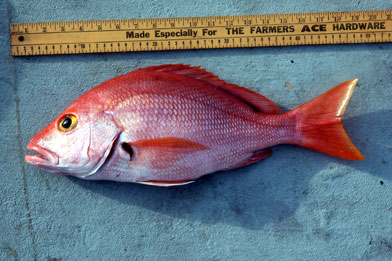
Dentition
The canine teeth on the upper jaw are larger than those on the lower jaw. There is also a V-shaped vomerine tooth patch located on the jaw.
Size, Age, and Growth
This snapper has an average length of 12 inches (30 cm) with a maximum length of 16 inches (40 cm). Sexual maturation occurs when females reach approximately 7 inches (18 cm) and males reach approximately 15 inches (38 cm). Average weight is 3-4 pounds (1.4-1.8 kg).
Food Habits
The blackfin snapper is a carnivorous predator, feeding near the bottom of the ocean. It is an opportunistic feeder, preying on any small fish within range. Young blackfin snapper feed on shrimp, worms, and other small invertebrates, switching to small finfish as they mature.
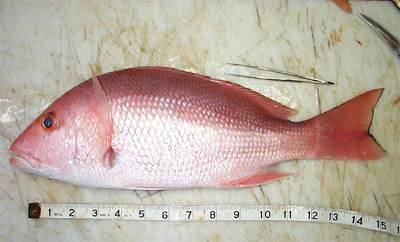
Reproduction
The blackfin snapper is known to spawn most of the year, with a peak in April and September, mainly off the coast of Jamaica. All snappers are oviparous, meaning they lay their eggs. These eggs and larvae are pelagic, utilizing the ocean currents as a means of dispersal. There is little known about the development of the larvae. Early juveniles (20mm) are pale blue with a wide yellow stripe extending from the dorsal lobe of the caudal fin to the middle or anterior end of dorsal fin. There is a dark black spot on the pectoral fin axil in older juveniles, but no dorsolateral spot.Predators
Natural predators of all life stages of this snapper are numerous and include sharks, barracuda, grouper, moray eels and other snapper species.
Taxonomy
Lutjanus bucanella was first described by the French naturalist Georges Cuvier in 1828. Mesoprion caudonotatus Poey, 1851 is a synonym used in past scientific literature that also refers to this snapper.
Prepared by: Rebecca Murray and Cathleen Bester